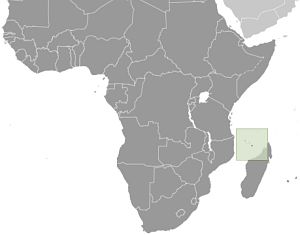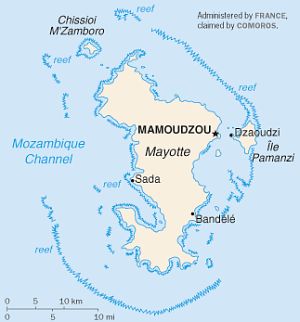French Colonies and Their Resources,
by James Bonwick, 1886, p.125-127:
MAYOTTE.
This is one of the Comoro Islands, on the western side of Madagascar, most of which group belong to Great Britain, as a dependency of Mauritius.
Nearly 300 years ago Mayotte had the reputation of a good harbour and a civilised people. The inhabitants, under Arab influence, had accepted Arab faith and customs. Subsequently it became the haunt of Mahometan and Christian pirates, thanks to the difficulties of approach to the shore.
In 1830 a Sakalava chief [Andriantsoly] fled before the victorious arms of Radama, the Hova king [Radama died in 1828, so, if the date is correct, this would have to be his wife, Queen Ranavalona], and took refuge in Mayotte, whose ruler received him well, and gave him his daughter for a wife. The Sakalava returned these good offices by driving out the lawful prince. Afterwards, having a revolt among his new subjects, he offered in 1840 to cede his rights to the captain of a French warship, if assured of a pension of £200 a year. Louis Philippe [1773-1850, King of France 1830-1848] readily acceded, and possession of the colony, so called, was taken in 1843.
The Mayotte island, latitude 12½° S., contains but 50,000 acres, and a population of 10,000, of which only 200 are French. Choa [Mamoudzou], the chief village, is to the north-east. Of volcanic origin, the soil is fairly good. Among its hills is one 2,000 feet in height. The plateau furnishes the most hopeful prospect for plantations, being removed from floods which heavy rains produce below. If protected from inundation, the alluvial deposits could be made profitable.
The winter torrents need storing against the dry season. Already there are extensive crops of sugar, coffee, tobacco, rice, cassava, vanilla, and provisions suitable to the native wants. Cocoa-nut oil is an important export.
There are no duties exacted, and no bank has been established. A commandant acts as ruler, and one magistrate is sufficient for the purpose of justice. All important cases are referred to Reunion.
For religion and education there are representatives of the orders of St. Joseph of Cluny and the Congregations of the Holy Spirit, having as many as twenty boys and eighteen girls under their care. The inhabitants, followers of Mahomet, though at a humble distance, get instruction from the old men of their race. The Jesuits, once the spiritual teachers, have been succeeded by Fathers of the Holy Spirit. Roman Catholic missions, though sustained by French authority and support, have slight effect on those semi-civilised races, who are apt to consider adorers of the Cross and images as idolaters.
The former capital is now chosen by the French as their seat of government. It is a small islet, Zaoudzi [Dzaoudzi], supposed to be somewhat less dangerous to health than the marshy Mayotte. Coral banks girt the land.
Though the island is but twenty miles in length, it is not without considerable capabilities, were the climatic difficulties alleviated by a system of drainage, which would be costly for the colony. Its position in the ship course of the Mozambique channel will give it a great advantage in the coming extension of commerce along the eastern coast of Africa, and particularly when the German occupation there has been turned to account.
The trade is largely in the hands of Banians from Bombay and Zanzibar, who exchange German and English goods for native produce. While France sent 172,000 francs of goods, and French colonies sent 717,000f., foreigners exported 438,000f. On the other hand only 179,000f. of the island's exports went to foreign countries, 303,000f. to French colonies, and 598,000f. to France. The tonnage is twice as much French as foreign.
|
One British pound was worth $5 US in 1840. The Federal Reserve Bank's estimated consumer price index shows that $1 in 1840 was equivalent to $21.51 in 2008. So the pension for which the right to rule Mayotte was sold to the French, was worth about $21,510 a year.
The US Mint reported in 1886 that the current value of the French franc was .193 US dollars. The Federal Reserve Bank's estimated consumer price index shows that $1 in 1886 was equivalent to $23.90 in 2008. Thus, 1 French franc in 1886 equals about $4.61 US in 2008.
Encyclopædia Britannica, v6, 1910, p.795:
COMORO ISLANDS...
3. Mayotte, about 21 miles long by 6 or 7 miles broad, is surrounded by an extensive and dangerous coral reef. The principal heights on its extremely irregular surface are: Mavegani Mountain, which rises in two peaks to a maximum of 2164 ft., and Uchongin, 2100 ft.
The French headquarters are on the islet of Zaudzi [Dzaoudzi], which lies within the reef in 12° 46' S., 45° 20' E. There are substantial government buildings and store-houses. On the mainland opposite Zaudzi is Msapérê [Mamoudzou], the chief centre of trade. Mayotte was devastated in 1898 by a cyclone of great severity...
All the islands possess a very fertile soil; there are forests of coco-nut palms, and among the products are rice, maize, sweetpotatoes, yams, coffee, cotton, vanilla and various tropical fruits, the papaw tree being abundant. The fauna is allied to that of Madagascar rather than to the mainland of Africa; it includes some land birds and a species of lemur peculiar to the islands.
Large numbers of cattle and sheep, the former similar to the small species at Aden, are reared as well as, in Great Comoro, the zebra. Turtles are caught in abundance along the coasts, and form an article of export.
The climate is in general warm, but not torrid nor unsuitable for Europeans. The dry season lasts from May to the end of October, the rest of the year being rainy.
The natives are of mixed Malagasy [from Madagascar], Negro and Arab blood. The majority are Mahommedans. The European inhabitants, mostly French, number about 600. There are some 200 British Indians, traders, in the islands.
The external trade of the islands has developed since the annexation of Madagascar to France, and is of the value of about £100,000 a year. Sugar refineries, distilleries of rum, and sawmills are worked in Mayotte by French settlers. Cane sugar and vanilla are the chief exports. The islands are regularly visited by vessels of the Messageries Maritimes fleet, and a coaling station for the French navy has been established.
The islands were first visited by Europeans in the l6th century; they are marked on the map of Diego Ribero made in 1527. At that time, and for long afterwards, the dominant influence in, and the civilization of, the islands was Arab. According to tradition the islands were first peopled by Arab voyagers driven thither by tempests. The petty sultans who exercised authority were notorious slave traders.
A Sakalava chief [Andriantsoly] who had been driven from Madagascar by the Hovas took refuge in Mayotte c. 1830, and, with the aid of the sultan of Johanna [another island in the area], conquered the island, which for a century had been given over to civil war. French naval officers having reported on the strategic value of Mayotte, Admiral de Hell [Anne Chrétien Louis de Hell, 1783-1864], governor of Réunion, sent an officer there in 1841, and a treaty was negotiated ceding the island to France. Possession was taken in 1843, the sultan of Johanna renouncing his claims in the same year.
In 1886 the sultans of the other three islands were placed under French protection, France fearing that otherwise the islands would be taken by Germany. The French experienced some difficulty with the natives, but by 1892 had established their position.
The islands, as regulated by the decree of the 9th of April 1908, are under the supreme authority of the governor-general of Madagascar. The local administration is in the hands of an official who himself governs Mayotte but is represented in the other islands by administrators. On the council which assists the governor are two nominated native notables. In 1910 the sultan of Great Comoro [Grande Comore, also Ngazidja or Ngasidja] ceded his sovereign rights to France. In Anjuan [Anjouan, also Ndzuwani or Nzwani] the native government is continued under French supervision.
The budgets of the four islands in 1904 came to some £30,000, that of Mayotte being about half the total. The chief sources of revenue are poll and house taxes, and, in Mayotte, a land tax.
|
One British pound was worth $4.87 US in 1904. The Federal Reserve Bank's estimated consumer price index shows that $1 in 1904 was equivalent to $23.90 in 2008. Thus, the Mayotte budget in 1904, about half of £30,000, was about half of $3,491,790 in 2008 US dollars.
The Statesman's Year-Book, by Martin, Keltie... v59, 1922, p.914:
MAYOTTE AND THE COMORO ISLANDS.
The archipelago of the Comoro Islands, is formed by the islands of Mayotte, Anjouan [also Ndzuwani or Nzwani], Grande Comore [Great Comoro, also Ngazidja or Ngasidja] and Moheli [Mwali]. Before 1912, Anjouan, Moholi and Grande Comore were only under French protection; Mayotte alone being a colony. But by a law of July 25, 1912, and a decree of February 23, 1914, the whole archipelago has become a colony, attached to the general government of Madagascar, of which it forms a twenty-third province, the 'Province des Comores.'
The island of Mayotte (140 square miles) had a population (1915) of 13,500. There is an increasing emigration to Zanzibar and Madagascar. The chief product was formerly sugar, but the cultivation of vanilla has now superseded that of the sugar-cane. There are now only two sugar works and two distilleries for rum. Besides vanilla and sugar, cacao, aloes and perfume plants (citronella, ylang-ylang [Cananga odorata], patchouli, &c.) are cultivated.
Grande Comore, Moheli, Anjouan, and a number of smaller islands, have an area of about 650 square miles and population in 1914 of 84,117. Vanilla, cacao and perfume plants are successfully cultivated. Grande Comore has a fine forest and exports timber for building and for railway sleepers.
The principal imports are cotton fabrics, metals, and rice; the principal exports, hides, sugar, and vanilla.
|
| | |
See also: Kenya - Tanzania - Comoros - Seychelles
South Africa - Mozambique - Madagascar - Mauritius
|
|
All of Mayotte is
one time zone at GMT+3,
with no Daylight Savings time.
|
Mayotte News
Mayotte was ceded to France along with the other islands of the Comoros group in 1843. It was the only island in the archipelago that voted in 1974 to retain its link with France and forego independence.
In March 2009, Mayotte voted overwhelmingly to become France's 101st department—and fifth overseas department—a change scheduled to become official in 2011.
CIA World Factbook: France
Area of Mayotte:
374 sq km
slightly more than 2x the size of Wash., DC
Population of Mayotte:
223,765
July 2009 estimate
Languages of Mayotte:
French official, 35%
Mahorian a Swahili dialect
Mayotte Capital:
Mamoudzou (Mamoutzou)
MAMOUDZOU WEATHER
Free Books on Mayotte (.pdfs)
Le Petit Futé Mayotte in French, online only 2008
Online Book Search Engines
Mayotte Reference Articles and Links
Wikipedia: Mayotte
Indian Ocean Maps
WikiTravel: Mayotte
Mayotte News Websites
Mayotte Hebdo in French
ABYZ: Mayotte News Links
|

